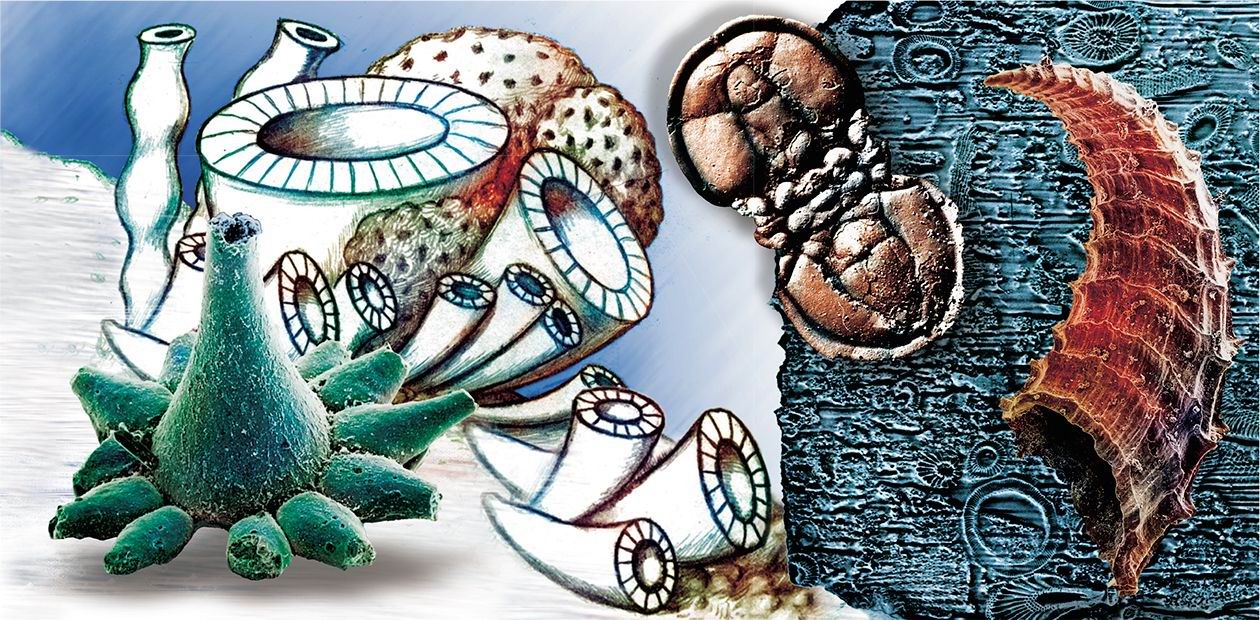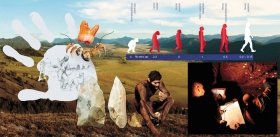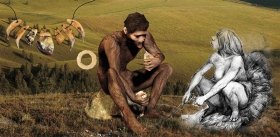From the Cambrian to the Creation
Fossil skeletal fragments, bones and shells, have been till recently almost the only evidence of past life. Yet organisms acquired skeletons about 500 Myr ago, whereas life itself turned to be older, much older than one could imagine …
The more we discover the surrounding world, the farther its origin moves back into the distant past. They are traces of fossil life — skeletons, shells, prints on rocks or shadows in crystals — that guide us through the abyss of old times …
No earlier than just a hundred years ago scientists thought that the Earth and the organic life were few hundreds of million years the oldest. Yet precise dating of rocks the advanced methods have allowed recently revealed a far older age of our planet, as old as 4.5 billion years!
The oldest finds of fossil life aged correspondingly. The origin of the first life is now estimated to be as early as 3.5 Byr but timing of its specific evolution stages is still being hotly debated.
TODAY IS THE PHANEROZOIC
Paleontology has contributed much to the understanding of early life by reconstructing extinct forms from the fossil records and, moreover, predicting their environments (oxygen contents, temperature, etc.).
Less the crucial point of its very origin, the life on the Earth underwent three key events:
•transition from prokaryotic (without nuclei)
to eukaryotic (with nuclei) cells;
•transition from single-celled to multi-cellular organisms;
•development of skeletonized support.
Paleontologists especially welcome the latter innovation, as buried skeletonized animals leave a far more durable and extensive record in sediments than their soft-bodied counterparts and provide the most complete account of the life history. It is studying fossils of the Phanerozoic, the time since organisms first developed a skeleton to present, that has long been the only source of knowledge about the life evolution.
Fossil skeletal fragments, bones and shells, have been till recently almost the only evidence of past life. Yet organisms acquired skeletons about 500 Myr ago, whereas life itself turned to be older, much older than one could imagine …
However, the more evidence of the early Phanerozoic life scientists were gaining, the more they understood that almost all extant forms lived already in the Cambrian, the earliest Phanerozoic period which started over 500 Myr ago. The questions naturally arose when did their ancestors originate, how did they look and how do they show up in the natural archives?
I am going to guide you back into the past from the point of 540 Myr, the Tommotian stage that begins the Cambrian.
CAMBRIAN EXPLOSION
The scrutinized Tommotian strata abound in fossils that record a true evolution acme, an outbreak of taxonomic diversification and offer an extremely extensive collection of paleontological evidence. The primitive Cambrian biota included common Phanerozoic sponges, molluscs, and brachiopods, though less abundant than unfamiliar animals which became known only from their fossil shells.
The Tommotian fossils are surprisingly minuscule. Adult molluscs have millimeter-scale shells and are an order of magnitude smaller than their nearest Ordovician progeny. Yet there are exceptions, such as some archaeocyaths. These extinct organisms, whose systematics is still uncertain and alternated between primitive sponge-like animals and an independent taxon, were first active builders of biohermal frameworks, the precursors of corals. Some individuals reached 1.5 m (!) high. Their fossil columns were found in Tuva, on the Shevelig-Kheme River. However, most Early Cambrian animals were typically of minute sizes.
The chemistry of many Cambrian skeletal fossils is their another remarkable feature. The carbonate and silicate skeletons coexisted at that time with phosphate species which constitute a great portion (50—70 %) of the oldest Cambrian sediments, though very few stayed longer than the earliest Ordovician.
Of course, the proliferous animal life in Cambrian seas was accompanied by abundant phytoplankton. Its traces are now found as numerous 10—100 mcm spherical fossils extractable from Cambrian rocks by dissolution in strong acids. Carbonate rocks contain remnants of CaCO3 secreting algae existing as minor centimeter-scale bushes. Stromatolite buildups of blue-green algae (cyanobacteria), though likewise small, are other ubiquitous tenants of Cambrian strata.
MUCH LOST LITTLE REMAINED …
The inventory of Early Cambrian fossils counts hundreds of species but it’s hard to tell how many taxa did exist. Plenty unidentified fossil objects show up in sediments as minute tubes, horns, pyramids, needles, etc.
There is much controversy over their origin with some paleontologists (especially Chinese ones) maintaining that these are separate organisms. Stephan Bengtson from Sweden and myself, we were among the first paleontologists who came to visit the celestial country after the cultural revolution, in 1978. The Chinese colleagues displayed about 200 fossil species, but actually there were almost ten times less.
In its billion-year long history, life has underwent three critical “science and technology revolutions” when cells with nuclei, then multi-cellular animals, and finally, mineralized skeletons first made their appearance on Earth
Many “species” were nothing but sclerites, i. e., skeletal fragments of organisms combined intricately into scleritomes. Scleritomes of some reconstructed animals contained up to ten varieties of sclerites! Thus, primitive skeletal organisms are very hard to study, more so if they have no extant counterparts.
The Cambrian evolution’s Big Bang was a key point in the biological history marked by geologically sudden massive appearance of organisms with a mineralized skeleton. Yet, the first organisms that developed skeleton-like features must have arrived on the scene much earlier.
TRACKS OF MYSTERIOUS CREATURES
Another stair down the time ladder (550—560 Myr) brings us to the latest Precambrian (Late Proterozoic) or the Vendian. Precambrian time was long believed to be virtually abiotic as Precambrian rocks appeared “mute”, barren of evident fossil life signature. The lack of life was however seeming.
Vendian strata turned out to store a great variety of rather advanced animals and plants which belong to the Ediacaran fauna. The Ediacaran fauna derives its name from its most notable locality, the Ediacaran hills in the outback of Southwestern Australia. Some paleontologists also refer to the Ediacaran fauna as the Vendian fauna or Vendobionta. Vendian fossils are extremely abundant in the cliffs along the White Sea in Russia.
Massive new fossil discoveries allowed a reconstruction of the general scenario of the cryptozoic evolution of the biosphere, the pre-Phanerozoic time of obscure soft-bodied life that spanned about 7/8 of the Earth’s history
Ediacaran organisms are remarkable being mostly soft-bodied and traceable from prints. Although many Ediacaran species were giant (some individuals reached 1 meter), they were jelly-like as the modern jellyfish which belongs to Coelenterata, possibly the most ubiquitous component of the Vendian fauna.
Plenty minuscule organisms and their fragments well preserved due to pectin outer covering are extracted from Vendian rocks by chemical treatment. Stromatolites, the tracers of cyanobacteria, occur profusely in Vendian carbonates worldwide. Shallow-water regions of Vendian seas were inhabited by vendotaenids, fairly large (up to few centimeters) filamentous soft-tissue algae.
Earliest primitive algae with calcium-carbonate shells are found at the Precambrian/Cambrian boundary. Some worm-like creatures (sabelliditids, anabarites, etc.) discovered in Late Vendian sediments developed an organic or mineral tube, the prototype of a skeleton. Bedding planes of rocks bear prints (tracks or burrows) possibly left by activity of some unknown animals.
The first appearance of metazoa on Earth was formerly assigned to the Vendian. Yet there is strong reason to think otherwise. The plausibility of the classic view, still stated in many student’s books, has been undermined by paleontological “mines”.
“PROBLEMATIC” FOSSILS
The “mines” were discovered as organic tubes with typical transverse striation in Upper Riphean (pre-Vendian or Upper Precambrian) sediments in China and in northwestern Russia (Timan Ridge, East European Platform). The tubes, remnants of worm-like animals commonly attributed to Polychaeta, were nearly the same as in the known Vendian and Early Cambrian sabelliditids, but for being as old as 700—750 Myr!
Udocania problematica Leites from the Udokan Formation (Siberia) described by A. M. Leites nearly 50 years ago is another remarkable fossil discovery which is often passed over in ignorance or hushed up on purpose. Udocanians encountered usually inside stromatolite frameworks resemble narrow conical tubes up to a few centimeters long. Respected paleontologists (R. Gekker, V. Manner, B. Sokolov) classify them either as Coelenterata or as tubemakers. Sounds like nothing strange, but the problem of Udocania problematica is its age the most conservative prediction places at 1.4—1.9 Byr!
However, the list of wonders is not complete with these discoveries. Grypania, the species contemporary to Udocania, known from Upper Riphean strata in China and North America was assigned by most paleontologists to metaphytes, or multi-cellular algae. A still older age of 2.1 Byr was predicted for an exquisitely preserved Grypania found later in Canada, though it grew slightly younger (1.85 Byr) due to more precise dating. Anyway, the hundreds of million years old Vendian, the acknowledged point of the metazoa onset, seems just a baby compared to that age.
Z. Walenczak, a Polish paleontologist, published striking results in the early 1980s. He examined, using special optic methods, various crystals in Archean metamorphics and found out that the presence of organic matter influenced crystal formation producing “shadows” of morphologically distinct biological objects reflected in lattice defects. Some organisms thus discovered in amphibolites from the basement of the East European Platform resemble cyanobacteria, others look like fungi. If this is true, we’ll have to admit the existence of multi-cellular eukaryotes since as early as 2.2—2.5 Byr ago!
To make the picture fuller, I should mention traces strikingly similar to those of Coelenterata colonies discovered by M. Fedonkin and E. Echelson and tracks from Lower Riphean strata (Siberian Platform), the discovery of B. Shishkin, stored in Novosibirsk. They look exactly like the tracks of the worm-like creatures, i.e., are left by multi-cellular organisms which were moreover complex enough to have a muscular body allowing creeping or burrowing. Imagine only they are dated at 1.4 Byr!
Now we leave for a while the enigmatic origin of metazoan animals and pass on to the last, or rather the first, innovation of life. I mean the emergence of eukaryotes.
ON INTO THE PAST
Eukaryotes are no less problematic. The first appearance of single-celled nuclei-bearing eukaryotes is very difficult to time precisely as they exhibit almost the same morphology as prokaryotes, especially the fossils. However, the cited finds of metazoan — certainly eukaryotic — organisms make doubt about the commonly recognized estimate of 1.65 Byr.
Eukaryotic cells apparently occur among acritarchs, spherical planktonic organisms with dense, though soft outer covering traceable in sediments down to the Archean.
Note that acritarchs have no unambiguous taxonomic assignment. They existed since 2.5 Byr ago or earlier as relatively large cells exceeding 60 mcm (much larger than almost all known prokaryotes). Therefore, eukaryotic organisms parental to the extant planktonic algae and protozoans must have inhabited the near-bottom sediments of seas already in the Archean.
Moreover, recent finds of molecular fossils, specific biomarkers, in Archean rocks evidence that eukaryotes lived as early as about 2.7 Byr ago. The molecular fossils are sterols, the components of membranes in eukaryotes, and the latter were thus capable of metabolic biosynthesis of sterols. With this extremely rapid aging, eukaryotes are progressively approaching the point about 3 Byr, which is at no distance from the origin of prokaryotes!
Finally, we have arrived at Archean microfossils and stromatolite-like forms, the oldest bacteria or even cyanobacteria fossils (older than 3.5 Byr) discovered by W. Schopf, M. Walter, F. Westall and other paleontologists. Note that scientists now find traces of bacteria in every rock, almost in every sample! Recent studies have shown that bacteria fossilize in just a few hours, too rapidly to destroy, and thus preserve even better than other organisms. Extremely thin 10—20 nm biofilms in rocks have reached us in the excellent state.
Therefore, new fossil discoveries move the origin of prokaryotes progressively back to the past almost as old as the Earth.
IS LIFE AS OLD AS THE EARTH?
Why to undertake the inventory of biochronology and tell so many stories about fossil records? It is not to prove the case but to outline some points of controversy in today’s biosphere science and to set up points that require further work. The cited absolute ages just allow an idea of the time and scale of events in the history of life and of the Earth itself.
Recent discoveries based on the multidisciplinary approach and advanced methods move the origin of life progressively farther back into the past, the life on the Earth, the planet that witnessed the weighty walk of dinosaurs as well as the light rustle of worm-like sabelleditids …
The finds of so old but rather advanced fossil organisms throw a new light on the critical global- scale geochemical processes such as the emergence of free oxygen and transition from reduced to oxidized air, as well as on changes of global climate with repeated glacials, on deposition history, etc.
SIBERIAN PLATFORM: LATE PRECAMBRIAN MICROBIAL FOSSILS
The Siberian Platform is a Precambrian stable crustal block. Its Late Cambrian section, almost throughout its depth, remarkably abounds in microbial fossils that represent the Lower Riphean — Upper Vendian life.
These finds show that the evolution pace culminated already in the Early Riphean (1650—1350 Myr), major taxonomic units appeared by the Riphean close, and some genera and families formed later, in Middle and Late Riphean time (1350—1150 and 1150—650 Myr, respectively).
First morphologically expressed eukaryotes in Siberian microbial fauna arrived on the scene in latest Early Riphean to reach a greater morphological diversity at 1150 Myr. Their dramatic taxonomic diversification occurred in Baikalian-Vendian time, while the pre-Baikalian Riphean evolution (850 Myr) was relatively slow.
К. Е. Nagovitsyn, Candidate in Geological and Mineralogical Sciences, Institute of Petroleum Geology SB RAS, Novosibirsk.
The paleontological evidence suggests that free oxygen became available as early as in the Archean and that the Earth’s surface then was not too hot (50—60° С). The common views of mineral forming in nature also need revision. For instance, it has been found out that bacteria participate in the formation of quartz, feldspar, clay and other sedimentary minerals (over 100 all in all!). Finally, it was a sensation to learn that forsterite, a mineral present in metamorphosed igneous rocks, can form as a result of bacterial activity under normal pressures and temperatures. If proved, these data will make another mine under the traditional idea of the Earth’s history and the biosphere evolution.
This is the point where we stop, even if the reader is still left with some doubts about the precise age of complex, or whichever, life on the Earth. First, because many specialists are as full of doubts as the reader is. But what is more important, the insight into the origin and evolution of life, when we easily handled millions and billions of years, offered us a unique opportunity to transcend the limits of the ephemeral human existence and feel ourselves immortal, at least for a short while, immortal as the life itself...
Editors thank P. Parkhaev (PIN RAS, Moscow), A. Postnikov, and K. Nagovitsyn (IPG SB RAS, Novosibirsk) who were very helpful in preparing the publication










